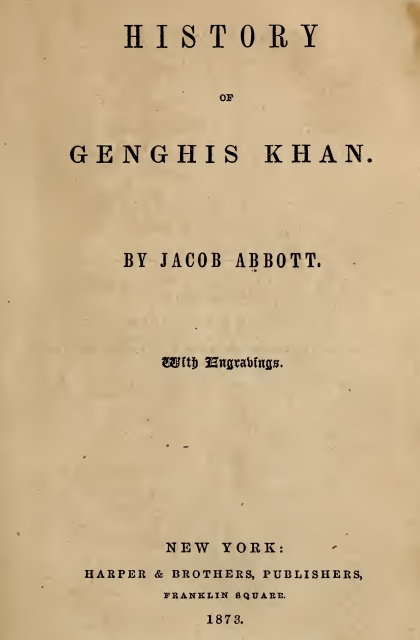
Genghis Khan by Jacob Abbott tells the story of Temujin’s rise from outcast to ruler of the largest land empire in history. Through courage, strategy, and ruthless leadership, he united the Mongol tribes and conquered vast territories. This classic biography highlights his military genius, governance, and lasting impact on world history—offering timeless lessons in leadership, resilience, and ambition.
Audio Note Option Comming Soon...
Genghis Khan by Jacob Abbott is a classic historical biography that chronicles the life and legacy of Temujin, the man who would become the legendary Mongol conqueror known as Genghis Khan.
Written in the 19th century for a young audience, Abbott’s narrative is clear, engaging, and rich in storytelling, making it one of the most accessible introductions to one of history’s most formidable leaders.
While not a modern academic work, Abbott’s book captures the rise, rule, and impact of Genghis Khan with a focus on character, leadership, and destiny.
“A single man, born in obscurity, rose to command an empire that stretched from the Pacific Ocean to Eastern Europe.”
This summary walks you through the key events and lessons from Abbott’s account, offering a concise yet powerful overview of how Genghis Khan built the largest land empire in history.
Genghis Khan—born Temujin around 1162—was the son of a minor Mongol chieftain. His early life was marked by hardship, betrayal, and survival.
Abbott describes how:
“He learned early that the world rewards strength, cunning, and resilience.”
These experiences forged a leader who was both ruthless and strategic—driven by a desire for unity, loyalty, and conquest.
Abbott highlights how Temujin didn’t rise through inheritance—but through vision, loyalty, and relentless ambition.
Key moments in his rise include:
“He did not conquer the Mongols—he united them.”
This unification was his first great achievement. Before Genghis Khan, the Mongols were scattered, warring clans. He turned them into a single, unstoppable force.
Abbott emphasizes Genghis Khan’s military brilliance and leadership principles, which made his army one of the most effective in history.
The Mongol army was built around horseback warfare. Light cavalry could travel up to 100 miles a day, striking fast and retreating before enemies could respond.
Genghis Khan used fear as a weapon. Cities that resisted were often destroyed. Those that surrendered were spared—creating a powerful incentive to surrender.
Unlike most rulers of his time, Genghis promoted men based on ability, not birth. Loyal and skilled warriors rose quickly, regardless of origin.
The Mongol army was highly structured, with units of 10, 100, 1,000, and 10,000 soldiers. This allowed for precise command and control.
Genghis used spies and scouts to gather information about enemy lands, politics, and weaknesses—long before invasion.
“Victory comes not from brute force, but from preparation and precision.”
Under Genghis Khan, the Mongol Empire expanded rapidly across Asia.
Abbott details major campaigns:
“No empire stood firm against the storm of the Mongol horsemen.”
By the time of his death in 1227, Genghis Khan ruled an empire that stretched over 12 million square miles—larger than any before.
Contrary to the image of a mindless destroyer, Abbott shows that Genghis Khan was also a visionary ruler.
He established:
“He built as much as he broke.”
His empire became a bridge between East and West, enabling cultural exchange, economic growth, and the spread of ideas.
Abbott’s narrative offers timeless leadership insights:
Genghis rewarded loyalty fiercely and punished betrayal without mercy. His inner circle remained devoted to him.
He adopted new technologies (like Chinese siege engines) and tactics from the people he conquered.
He shared hardships with his men, ate the same food, and fought on the front lines.
He didn’t just conquer—he created a shared identity among the Mongols.
He showed mercy to those who surrendered but made examples of those who resisted.
“A leader must be both lion and fox—strong and cunning.”
Abbott provides glimpses into Genghis Khan’s personal world:
“He was a man of the steppe, never fully at home in palaces.”
Despite his power, he lived modestly compared to other rulers of his time.
Abbott contrasts Genghis Khan with his enemies—often powerful kings and emperors who were overconfident, divided, or corrupt.
Examples include:
“Pride goes before destruction, and a haughty heart before a fall.”
Genghis Khan’s success was not just due to strength—but because his enemies failed to adapt.
Abbott explores the mindset that drove Genghis Khan:
“He was not driven by greed—but by a mission to dominate and organize.”
His ambition was not for personal luxury, but for power, legacy, and control.
Genghis Khan used several key tools to maintain his empire:
“He ruled with an iron fist—but also with intelligence.”
Jacob Abbott’s Genghis Khan is not just a biography—it’s a study in power, leadership, and human potential.
It teaches that:
As Abbott writes:
“Few men in history have left such a mark on the world as Genghis Khan.”
Though often remembered for destruction, his empire laid the groundwork for the Pax Mongolica, a period of peace and trade that connected continents.
“He was not just a conqueror—he was a force of history.”
Comments
2Thanks for sharing!
Add English audio book